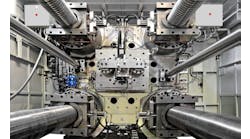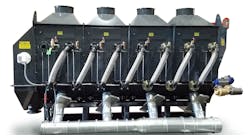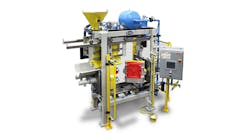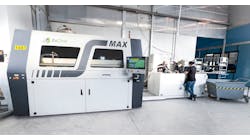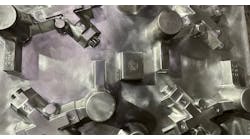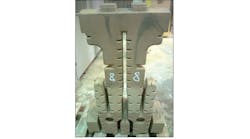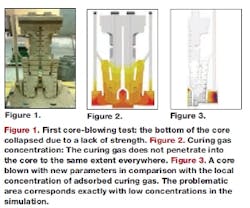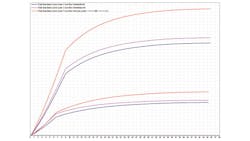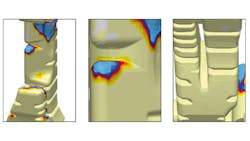Latest from Molds/Cores
Usiminas is one of Brazil’s largest steelmakers, and its business unit Usiminas Mecânica is one of the largest metalcasting operations in that country. It designs and produces engineered steel castings for heavy equipment used in steelmaking, mining, automotive production, power generation and petrochemical process, shipbuilding, and infrastructure projects.
See the images included in this Gallery
Those are complex, high-value castings, and recently Usiminas recently adopted coremaking simulation using Magmasoft® as part of a strategy to improve its designs and establish reliable production processes for its core producing line.
Magmasoft is part of a comprehensive platform of modular simulation software used by metalcasters around the world, especially to optimize cast component designs and production processes in automotive and heavy industrial applications.
The primary objective for the Usiminas foundry was to optimize the process conditions for an existing tooling layout. One particular core, called the thin waist core, represented some of the biggest challenges for Usiminas: its length (920 mm), substantial changes in the sand flow direction during blowing, the need to fill certain parts of the core through counter-flow, and big variations in the cross section within the core, undermined the consistency of the coremaking process.
First trials showed problems with the process, which led to a complete collapse of the lower part of the core. The core blowing and curing steps for the PU coldbox process were analyzed, making it possible to draw preliminary conclusions about the defects.
The lack of core strength was related to a poor curing process. The first simulation showed that the problematic regions experienced only very low curing gas concentrations during gassing, and this was identified as the root cause for the failure.
Analyzing process conditions
On the production line, process conditions like curing and purging times and gassing pressure were changed, which improved results. However, a perfect core could still not be produced. Further analysis with Magmasoft evaluated the local concentration of adsorbed curing gas, and indicated the regions where the catalyzing gassing agent cannot activate the chemical reaction. This result demonstrated clearly that only a very small quantity of catalyst was available to accelerate curing in the defect regions.
Evaluating simulated curves for the gas mass flow through the vents made it clear that the catalyzing gas was not reaching the critical area. The open venting cross section of the top and central vents were allowing the gas to escape before it reached the bottom of the core.
Instead of modifying the core box, a considerable expense, Usiminas determined that a possible, and simple solution was to close some vents in the top and center regions in order to increase the gas concentration in the bottom. However, it was clear that these changes would influence the core-blowing step, too.
The optimization led to a considerable increase (~36%) of the curing gas concentration in the lower regions of the core. Also, the amount of adsorbed curing gas increased in comparison to the original project. Applying these modifications, Usiminas produced another core, which showed no gassing defects. Because the venting area was reduced, some filling defects were present, as expected.
Having solved the curing-related defects, the engineers conducted a further core-blowing analysis. The simulation results showed a very good match between the real defects and areas of low packing density. The flow animation also showed that the problems occurred because these areas had to be filled by a counter flow of the sand.
Another characteristic of the defects was that all of them occurred next to the parting line of the core box. Some of the defects showed a smooth surface, indicating that sand had been removed by a strong airflow. Core-blowing simulation results supported Usiminas’ conclusion that an improper sealing of the tool was the root cause for these defects. Air could escape with high speed through the parting lines, resulting in the defect formation.
This hypothesis was tested using a silicone rubber band to obtain an improved sealing of the relevant areas of the tool. With that modification, a new core was produced that was entirely free of defects.
Software for casting process simulation
Casting process simulation software considers the entire casting sequence, including mold filling, solidification, and cooling, and provides the quantitative prediction of mechanical properties, thermally induced casting stresses and the distortion of cast components. Simulation accurately describes a cast component’s quality “upfront,” Magma emphasized, before production starts. Thus, the casting layout can be designed with respect to the required component properties. This results in a reduction in pre-production sampling, but also the precise layout of the complete casting system leads to energy, material and tooling savings for the foundry.
The range of applications for Magma solutions covers all cast alloys, from cast iron to aluminum, for sand casting, permanent mold casting, and diecasting, as well as large steel castings like those Usiminas manufactures. The software supports component design, helps to determine melting practice and casting methodology, including moldmaking, heat treatment, and finishing. This saves design and production costs throughout the casting manufacturing sequence, according to the software developer.
